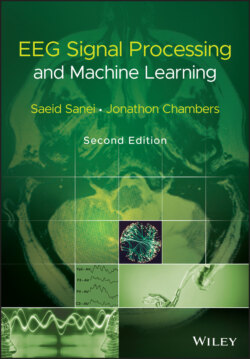Читать книгу EEG Signal Processing and Machine Learning - Saeid Sanei - Страница 79
4.9 Principal Component Analysis
ОглавлениеAll suboptimal transforms such as the DFT and DCT decompose the signals into a set of coefficients, which do not necessarily represent the constituent components of the signals. Moreover, the transform kernel is independent of the data hence they are not efficient in terms of both decorrelation of the samples and energy compaction. Therefore, separation of the signal and noise components is generally not achievable using these suboptimal transforms.
Expansion of the data into a set of orthogonal components certainly achieves maximum decorrelation of the signals. This enables separation of the data into the signal and noise subspaces.
Figure 4.12 The general application of PCA.
For a single‐channel EEG the Karhunen–Loéve transform is used to decompose the ith channel signal into a set of weighted orthogonal basis functions:
(4.117)
where Φ = {ϕk } is the set of orthogonal basis functions. The weights wi, k are then calculated as:
(4.118)
Often noise is added to the signal, i.e. xi (n) = si (n) + vi (n), where vi (n) is additive noise. This degrades the decorrelation process. The weights are then estimated in order to minimize a function of the error between the signal and its expansion by the orthogonal basis, i.e. e i = xi − Φwi . Minimization of the error in this case is generally carried out by solving the least‐squares problem. In a typical application of PCA as depicted in Figure 4.12, the signal and noise subspaces are separated by means of some classification procedure.
